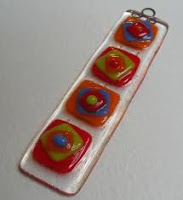“I'm making 3mm French Vanilla sconce covers; …
·
[initially they were] fine, but now 1.5"
bubbles form during the full fuse.
·
I pop the bubbles and fill the holes with
frit and refire,
·
[The]… edges draw in and distort the design…
·
The shelf is flat,
·
I fire on Bullseye paper, and
·
the 13.5 hour long firing schedule [in F] is:
200 to 1150, hold 30 minutes.
50 to 1225, hold 30 minutes.
300 to 1490, hold 30 minutes.
9999 to 990, hold 60 minutes.
100 to 750, hold 1 minute.
Does anyone know what I can do to avoid the large bubbles?
A critique of the schedule.
This is for a single sheet of 3mm glass, so the hold at 621˚C/1150˚F is unnecessary as is the slow rise to and hold at 663˚C/1225˚F, because it is a single sheet and does not need the traditional bubble squeeze.
The hold of 30 minutes at 810˚C/1490˚F is excessive.
·
The temperature may be too high.
·
Ten minutes at top temperature is sufficient in
most cases.
·
A soak of 1 minute would be enough.
·
The anneal soak at 990˚F is most probably a
misprint for 516˚C/960˚F.
·
The anneal soak is longer than the half hour
necessary, but not a bubble creating problem.
It
means the schedule could have been:
111˚C/200˚F to 796˚C/1465˚F for 5 minutes
AFAP to 516˚C/960˚F for 30 minutes
83˚C/150F˚ to 370F˚/700F˚, 0 minutes
Off
Different firing strategies are
possible.
- Reduce the time at top temperature to no more than 10 minutes.
- Reduce top temperature by 55˚C/100˚F or more and extend the soak to 20 minutes, if necessary. Peek frequently to see when the kiln work is complete.
- Fire on fibre paper covered with Thinfire to allow air out from under the glass.
These strategies can be mixed as desired,
and the reasoning for the strategies is:
- Excessive time at the top temperature allows the glass to thin as it migrates to form thicker areas/edges. This makes the glass too thin to resist the air pressure from below.
- Reducing the top temperature will increase the viscosity, so resisting the migration of the glass, and maintain the original thickness.
- Also, single layers are prone to dog boning, but there are ways of reducing it.
Ways to reduce the risk of bubbles appearing in general are:
- Reduce the time at the top temperature,
- Reduce the top temperature,
- Provide ways for the expanding air to migrate from under the glass.











